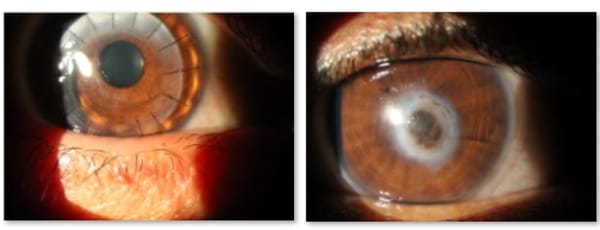CORNEAL TRANSPLANTATION: A VISIONARY GIFT

Dr Ashok Sharma
GMC Jammu is proud to host Corneal Awareness Fortnight, a dedicated event aimed at spreading awareness about the importance of corneal health and the life-changing impact of corneal transplants.

This fortnight is an opportunity to educate, inspire, and mobilize our community to help those suffering from corneal blindness. By spreading knowledge and dispelling myths, we can encourage more people to become eye donors and give the gift of sight. Together, let’s shine a light on the power of corneal transplants, support those in need, and take a step closer to a world where everyone can see the beauty of life. Understanding Corneal Transplantation: Corneal transplantation, also known as keratoplasty, is a surgical procedure where damaged or diseased corneal tissue is replaced with healthy donor tissue. This process can involve either a full-thickness replacement, called Penetrating Keratoplasty, or a partial-thickness replacement, known as Lamellar Keratoplasty or Endothelial Keratoplasty. Why is Corneal Transplantation Performed?

Corneal transplantation can be performed for several reasons: *To Improve Vision (Optical Grafting): For patients with conditions that impair vision.
*To Treat Infections (Therapeutic Grafting): When infected corneal tissue does not respond to other treatments.
*To Restore Eye Structure (Tectonic Grafting): To maintain the integrity of the eye. *To Enhance Appearance
(Cosmetic Grafting): To improve the eye’s appearance in certain conditions.
Who Needs Corneal Transplantation?
This surgery is typically performed on patients suffering from:
*Mechanical or chemical injuries to the eye
*Eye infections like keratitis *Corneal opacity
*Post-cataract surgery edema *Corneal dystrophies and degenerations
The Procedure: The surgery is tailored to each patient’s needs and can be done under local or general anesthesia. After the patient is anesthetized, the surgeon uses a speculum to keep the eyelids open and takes precise measurements to determine the amount of donor tissue required. The damaged corneal tissue is carefully removed, and the healthy donor tissue is sutured into place with fine stitches. After the procedure, which usually takes 30-45 minutes, the eye is protected with a shield or patch.
What to Expect After Surgery: Healing from corneal transplantation is a gradual process, and it may take up to a year for vision to fully stabilize. During this time, patients may need to wear contact lenses or eyeglasses and use prescribed eye drops. It’s important to avoid any potential injury to the eye. If you notice any redness, irritation, pain, or a decline in vision, contact your ophthalmologist immediately, as these could be signs of graft rejection. Regular follow-ups are essential to monitor recovery.
Give the gift of sight: donate your eyes
In a world where clear vision is often taken for granted, eye donation stands as a beacon of hope for those suffering from blindness. According to the World Health Organization, at least 2.2 billion people worldwide live with visual impairment, and 6-8 million of them suffer from corneal blindness. Corneal blindness occurs when the cornea, the transparent layer at the front of the eye, becomes damaged or diseased. For many of these individuals, a corneal transplant is the only solution, relying on the availability of healthy donor corneas.
Why Eye Donation Matters
Eye donation is a generous act that can bring the gift of sight to someone in need. Unfortunately, many people are unaware of the importance of eye donation or are held back by misconceptions. Let’s clear up some common myths and provide important information about eye donation.
Who Can Donate?
Anyone can donate their eyes, regardless of age or gender. Even those with certain ocular conditions like refractive errors, cataracts, or systemic disorders such as diabetes and hypertension can donate.
Who Cannot Donate?
Individuals with conditions like hepatitis, AIDS, rabies, septicemia, encephalitis, leukemia, or lymphoma are not eligible to donate their eyes.
When Can You Donate?
Eyes can only be donated after death. A person can pledge their eyes during their lifetime, or the family can decide to donate after the person has passed away.
Timing of Donation
It’s ideal to donate eyes within 6-8 hours of death. The retrieval process takes about 15-20 minutes.
Where Does Eye Donation Occur?
Eye donation can take place either in a hospital or at the deceased’s home. The procedure is performed with great care to ensure no disfigurement.
Whom to Contact?
Family members should contact the State Organ and Tissue Transplant Organization (SOTTO). They will coordinate with the local eye bank to manage the process.
What to Do While Awaiting the Team?
Keep the eyes closed with a moist cloth over them and turn off fans while turning on the AC, if available, to help preserve the tissue until the donation team arrives.
Illuminate Lives: Be the Light
Eye donation is a powerful act of compassion and generosity that offers a lifeline to those affected by corneal blindness. By choosing to donate your eyes, you can restore vision, improve lives, and leave a lasting legacy of kindness. Register as an eye donor, inform your loved ones of your decision, and help spread awareness. Together, we can break down barriers, spread the word, and give the gift of sight.
Be the light in someone’s darkness, be the hope in someone’s despair.
(The author is Head of Department of Ophthalmology, GMC Jammu)
